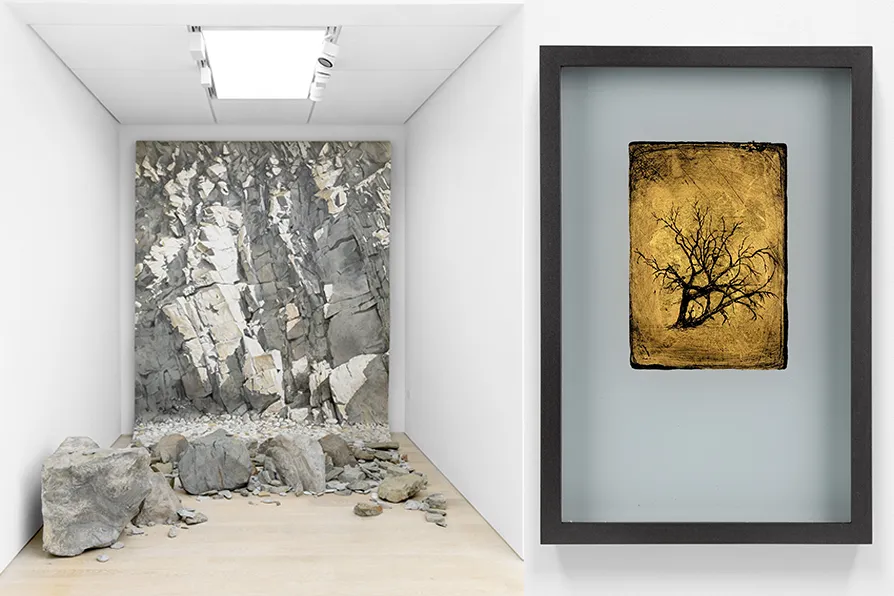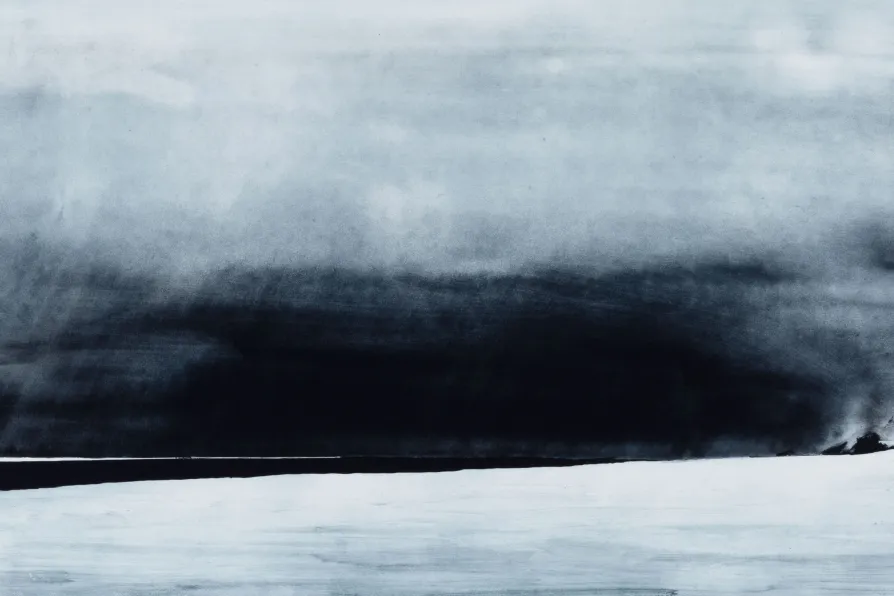JAN WOOLF examines work that aims to give viewers a material experience of the environments in the polar north and Britain equally affected by the climate crisis

 (L) Emma Stibbon, Rock Fall, Bideford Bay, 2025; (R) Miriam de Burca, Sentinel V - Drought, 2024 [Pics: © the artist/Courtesy of Cristea Roberts Gallery]
(L) Emma Stibbon, Rock Fall, Bideford Bay, 2025; (R) Miriam de Burca, Sentinel V - Drought, 2024 [Pics: © the artist/Courtesy of Cristea Roberts Gallery]
Emma Stibbon: Melting Ice | Rising Tides,
Cristea Roberts Gallery, London
⭑⭑⭑⭑☆
EMMA STIBBON is one of our finest and most committed landscape artists – so committed, that she often makes her work with the very stuff of her subject matter: the chalk of Birling Gap East Sussex used on black prepared paper; ground rock with the texture of ground almonds, and Eastbourne’s inky sea water.

While she is out in the field working, the weather too can make its way onto her surfaces. Snow falls on some, rain splats on another. Sometimes the media she works with is the weather frozen onto the surface. This is not gimmick (she works with geologists and scientists). “Situationist” possibly, like Turner lashed to a ship’s mast.
This preparatory work is then finished in her Bristol studio.
Her mission in this show is to link vanishing polar ice with surging sea levels and the consequent erosion of UK coastlines, whether the soft crumbling Sussex chalk or the harder rock of North Devon. Sea levels are predicted to rise by 1.5m by the end of the century, and this is her response.
“I feel working from landscape today has never been more pressing. I’m increasingly aware that I am living through a time of unprecedented change and that we need to understand what we are doing, and what we stand to lose.”
The show contains an installation, Rock Fall, Bideford Bay. Rocks and stones laid at the foot of a large drawing of a cliff face. For all its size and materiality, I found this worked less powerfully in the imagination than the drawings. Likewise, Breaker, the work hanging opposite, which at first encounter can be experienced as kitsch, with its approximation to those large sea-wave reproductions that used to hang with the Green Lady in leading brands of chemists back in the day. Of course, when we look into it we see the skill and power.
Like Casper David Friedrich, Stibbon considers the sublime; from the Latin “sublimis” meaning uplifted, lofty, exalted (sorry, couldn’t help myself) to suggest that humanity can no longer admire spectacular scenes of nature from afar, but needs to get down and dirty, being right there — inside the frame.
Considered an heir of Turner and Constable in this commitment - and in many respects technique – the show is mostly monochrome and free of people. T and C had a few but their commitment to the scape and the scope of the land was radical at the time. I always like to repeat the story of when a leading critic of the day took fright at a Constable, demanding “take away this nasty green thing!”
Might an industrialist say of a Stibbon, take away this nasty grey thing? The very people – and here’s the contradiction – that operate and thrive in Pall Mall, this terribly wealthy part of central London, are those that are eroding the planet, no?
Yet Cristea Roberts gallery are members of the Climate Crisis Coalition and show Emma Stibbon with pride. They have a dedicated “green team” and I was assured that this is not art washing. It’s here for Climate Art Week. This is, to quote John Berger, a “Way of Seeing” climate crisis. One work, Gjertsenodden, Svalbard 2024 has been acquired by the British Museum.
Her work is not verisimilitude; the marks and expressions bring an uber reality. She studies the land/ice/cliff scape the way Jenny Saville does the human face – yet as (some) humans thrive, Stibbon’s lands crumble and erode.
Is this politically engaged art? In a way, but it feels beyond that. Planetarily engaged? Certainly. Yet again, here is an artist revealing the truth. I asked her: “Your work has a terrible beauty. At what point do you know that each piece is ready for you to step back, knowing its optimum impact?’
“I feel the term ‘a terrible beauty’ is very fitting. Many of the places I work in have such wonder and beauty, but it’s impossible not to feel a pathos realising how rapidly climate-induced change is happening. Knowing when to leave an image as finished is a balancing act. Working on paper with quite delicate drawing media it’s easy to overwork something. I usually live with an image on the studio wall for a while so I can decide. My intention is to give the viewer a sense of being there. It’s as if I’m trying to revisit that experience.”
Downstairs at Cristea Roberts is an accompanying show, A Threatened Landscape. More work by Stibbon includes a fabulous mono-print of the volcano Stromboli. Then there are soil sisters Christiane Baumgartner and Miriam de Burca, brothers Richard Long, David Nash, Yinka Shonibare and Joe Tilson. I was particularly struck by Irish artist Miriam de Burca’s series Noblesse Oblige. But she’s another story and I look forward to telling it.
Runs until November 22, admission free. For more information see: cristearoberts.com

JOHN GREEN is stirred by an ambitious art project that explores solidarity and the shared memory of occupation

MIKE QUILLE applauds an excellent example of cultural democracy: making artworks which are a relevant, integral part of working-class lives

SYLVIA HIKINS casts an eye across the contemporary art brought to a city founded on colonialism and empire

ANGUS REID applauds the ambitious occupation of a vast abandoned paper factory by artists mindful of the departed workforce










